Syzygium smithii



Scaly
Scaly bark has a mottled textured and sheds in plates or scales.
Broad domed
Trees with a broad spreading dense crown.This large tree has an erect trunk that becomes buttress with age and dark brown scaly bark. The spreading smooth branches form a dense crown with glossy green ovate leaves and the fluffy-like white flowers appear in summer, followed by purple berries.
Syzygium smithii (Poir.) Nied. is naturally found on the east coast of New South Wales in Australia. It grows in dry and wet sclerophyll forest and rainforests, commonly along creeks in wetter coast and montane regions, appearing from sea level to an elevation of 1,000 m (3,280 ft). In littoral rainforests or coastal heath and shrubland the tree may be reduced to a small lignotuberous shrub. It grows in medium to heavy, silty organic rich loam that is acidic with a pH range from 4.5 to 6.5 and tolerates temporary inundation. It prefers a sunny to semi-shaded humid wind protected position in a sub-tropical to warm or cool temperate and Mediterranean climates. It is drought and light frost tolerant with a preferred minimum winter temperature of 5ºC (41ºF).?
Lillypilly is grown for is upright spreading crown and its glossy green leaves. It is planted in large gardens and parks as a lawn specimen for shade or is used in rainforest settings in coastal and adjoining hillside regions. It has a vigorous growth rate establishing in 3 to 5 years and is long lived, attracting birds, bees and butterflies. This tree is also used in pots and tubs when young but smaller cultivars of the species are commonly planted in gardens for screening or as a specimen. Once established it has a medium water requirement, (Scale: 2-drops from 3) preferring to have reliable moist organic rich soil for optimum growth but will tolerate dry periods.
I.D. 237
UK hardiness zone H1c
Climate zones 15 - 17, 19 - 24
USDA Zone 9-11
Syzygium (siz-ZY-gee-um) smithii (smith-e-eye)
Etymology
Genus: Greek Syzygium– ‘syzygos’ (coupled), referring to the manner in which the branches and leaves are united by pairs
Species: smithii – after English botanical author, Sir James Edward Smith
Variety
Minor Small Leafed Lillypilly
This small tree grows to 6 m (20 ft) tall by 3 m (10 ft) wide forming a shrubby habit with glossy dark green leaves. It has fluffy-like white flowers that appear in clusters during summer followed by deep mauve editable fruit during winter. It is suitable for seaside gardens as a specimen or in shrub borders for screening and tolerates regular punning to shape. It is drought and frost tender and has a medium water requirement once established.
Fine Leaf Form
This tree produces a finer leaf that is flushed bronze when young otherwise it is the same as the species. It has a medium water requirement once established.
Red Tip Form
This tree produces leaves that have a red tip otherwise it is the same as the species. It has a medium water requirement once established.
Cultivar
'Allyn Magic'
This dwarf form grows to 1m (3ft) tall with a bushy low mounded habit and has small bronze-green new foliage that that matures to glossy green and is pimple psyllid free. It is an excellent plant for small gardens, containers and as a low border, or may be mass planted and trimmed to form a low hedge. It tolerates most moist well drained moderately fertile sandy to loamy soils. It grows in a open sunny to semi-shaded position, responding to mulching and reliable moisture. It is suitable for coastal regions and moderately frost tolerant with a medium water requirement once established.
'Elizabeth Isaacs'
This dwarf form has pink-cream new growth changing to variegated older growth usually with a cream margin. It is used in small gardens and parks. It is suitable for coastal regions and moderately frost tolerant with a medium water requirement once established.
'Minipilly'
This shrub grows to 2 m (6 ft) tall and wide forming a dense shrubby habit. It has dark green foliage with reddish new growth and produces creamy fluffy flowers during summer that are followed by clusters of pink to red berries that are persisted on the plant. it prefers an open sunny to semi shaded position and may be trimmed to form an informal or formal hedge.
Rheophytic Race
This small bird attracting tree grows to 5 m (15 ft) tall by 3 m (10 ft) wide with low spreading branches that form a compact habit with small glossy green leaves. The fluffy-like white flowers appear profusely during summer and are followed by editable deep mauve berries. It tolerates most well drained moist to wet fertile soils in a full sun to shaded position and is suitable for coastal regions. It is used as a specimen tree in small gardens or parks or planted in shrub borders for screening and may be trimmed to form an informal hedge. It tolerates light frosts and has a medium water requirement once established.
'Sublime' PBR
This small conical tree grows to 5 m (15 ft) tall with lime-green new growth and produces masses of dense white flowers during summer followed by deep mauve editable berries. It grows in a sunny to semi shaded position tolerating light frost and will grow in most well drained to wet soils. This small tree is planted as a specimen in parks or gardens and may be used for street plantings. It is also planted along borders for screening and may be pruned to form a hedge.

Australia (east coast)
Myrtaceae (mir-TAY-see-ee)
Myrtle, Eucalyptus, Clove and Guava Family
This is a large family of shrubs, mallee and trees with showy stamens and peeling bark. It has a large representation in the Australian landscape.
Distribution
The plants in this family are predominantly found in the southern Hemisphere with 75 genera native to Australia and the remaining distributed in South America, Africa and the neighbouring islands. They are located in tropical rainforests, sclerophyll, heaths and woodlands in rich to poor dry soils.
Diagnostic Features
The simple leaves are normally opposite; occasionally spirally arranged with no stipules and normally an entire margin. There are pellucid oil glands dotted on the leaf, which may be obscured and when the leaf is crushed it is aromatic.
The juvenile, intermediate and adult leaves may be different in arrangement and shape on the same plant.
The regular flowers are hermaphrodite or sometimes unisexual and may be axillary, solitary, or arranged in cymes, umbles, terminal spikes, racemes or panicles. The floral tube covers the ovary and may continue above the ovary summit and form a disk around the ovary.
There are 4 to 5 sepals and petals normally fused to form a calyptra or are free.
The stamens are five to many and may be free or fused into 5-bundles that are opposite the petals.
They have an inferior to semi-inferior ovary that has 1 to 10 carpels, normally five with 1 to many ovules that are inserted on an axil that is basal or rarely a parietal placenta.
The style ends with a narrow stigma and the anthers normally open with longitudinal slits or pores.
The fruit may be a capsule, berry, nut or drupe-like with the cup that surrounds the ovary that is fleshy or dry and woody.
The seed may vary in structure and the cotyledons may be small or large.
Note:
This family has many attractive species and are extensively used in ornamental. Eucalyptus, Melaleuca, Callistemon and Thryptomrnes are just some of the plants represented and they are normally pollinated by insects, birds and in some cases by mammals.
This plant tolerates between USDA zones 9a to 11a and grows to 30 m (90 ft)
Fahrenheit 20º to 45º F
These temperatures represent the lowest average.
Celsius -3.9º to 7.2º C

Attention
This plant was last revised on the 25/05/2022
All photographs and data are covered by copyright. Apart from any fair dealing for the purpose of private study, research, reference or review, as permitted under the Copyright Act, no part including images and text may be reproduced by any means without written permission. The information presented in the map is only indicative and may contain errors and omissions. All inquiries should be addressed to sales@plantfile.com attention Peter Kirkland.

Simple
The leaf that is not divided.
Ovate
The leaf that is broadest at the base tapering towards the apex.
Opposite
Leaves that are arranged opposite to each other.
Entire
A leaf margin with no irregularities (smooth).
Cyathiform
A cup like shape.
Panicle
Branched with large loose clusters.| Jan | Feb | Mar | Apr | May | Jun |
| Jul | Aug | Sep | Oct | Nov | Dec |
The 15 mm (2/3 in) wide cyathiform flowers are creamy white with 4 funnel-shaped calyx lobes and 4 overlapping petals that are discarded as the flower expands with prominent (fluffy-like) stamens. They are arranged in a terminal panicle at the end of the branchlets and appear during summer.

Berry
A fleshy succulent indehiscent fruit, contains one or more seeds"| Jan | Feb | Mar | Apr | May | Jun |
| Jul | Aug | Sep | Oct | Nov | Dec |
The 20 mm (¾ in) profuse globular white to purple succulent berry discards the sepals and contains a single large seed. It is distributed by birds or gravity and the seeds have a short viability period and require a moist sheltered position to germinate.
Note;
The fruit may be eaten raw or made in to a tasty jam.
![]()
Lillypilly is grown for is upright spreading crown and its glossy green leaves. It is planted in large gardens and parks as a lawn specimen for shade or is used in rainforest settings in coastal and adjoining hillside regions. It has a vigorous growth rate establishing in 3 to 5 years and is long lived, attracting birds, bees and butterflies. This tree is also used in pots and tubs when young but smaller cultivars of the species are commonly planted in gardens for screening or as a specimen.
Note:
Care should be taken when selecting a sight allowing ample room for it to grow as it has vigorous roots that can lift concrete and block drains.
This plant is susceptible to Lichens but is resistant to Phytophthora cinnamomi.
Sow seed when fresh in a warm humid environment and allow up to 120 days for germination. Cultivars are grafted onto 2 year old understock.
Propagation by Seed (General)
Germination
In order for a seed to germinate it must fulfil three conditions.
1. The embryo must be alive (a viable seed).
2. The seed must have no dormancy-inducing physiological, physical or chemical barrier to germination; also the seed must be nondormant.
3. The seed must have the appropriate environmental requirements, water, temperature and oxygen.
The interaction between these requirements and dormancy is complex and may lead to different environmental requirements that avoid the dormancy of a seed.
Sowing Seeds in Containers
There are two general methods for germinating seeds.
1. Sowing seeds in a flat or germinating bed, through which seedlings are pricked-out then, transplanted into another flat with wider spacing or directly to an individual pot.
2. Sowing seeds by placing them in to flats with the appropriate spacing or into individual pots.
This method is normally carried out with medium to large seeds such as woody plants and plants that are difficult to transplant.
Seedling production normally occurs in a greenhouse / glasshouse, cold frames and on hot beds.
Method of Seed Sowing
Fine seed is sown in pots or flats that are no deeper than 70 to 80 mm. using a sterilised well-drained media (soil). Fill the container to 20 mm from the top and sprinkle sieved peat to 3 mm depth.
Press the media down level and firm with a piece of timber and then thoroughly moisten.
Mix the fine seed with washed sand and then sow thinly on the surface. These may be lightly covered with sand.
Larger seeds may be covered with media or a hole is dibbled and the seed is placed in the media.
Watering Methods
For watering you may either mist the containers from above or place the container in tepid water and allow the water to raise through the pot to the surface of the media, then drain away and do not fill to the top of the container.
Place a piece of glass over the pot and store in a protected warm environment (glasshouse).
Seeds germinate best in darkness so shade the containers if in direct sunlight.
After the seedlings have sprouted remove the glass and ease the seedlings into direct light.
When the seedlings are large enough prick them out and transplant into larger containers then place them in a shade house to harden off.
Many seeds have different methods of seed preparation for germination such as nicking or cutting the seed coat to allow water penetration, also placing seeds in hot water and allowing it to cool off.
This is particularly important as it is softening the seed coat.
Grafting and Budding (General)
Grafting and budding have many different purposes.
1. It produces clones that are otherwise unobtainable through cuttings, layering and division.
2. To gain the benefits of certain rootstocks.
3. Changing cultivars of established plants.
4. It accelerates the reproductive maturity of seedlings in a hybridisation program.
5. Repairing damaged parts of trees.
Grafting is the joining two pieces of living tissue as so they grow into a single living plant there is 5 requirements for a successful graft.
1. The stock and the scion must be compatible.
2. The scion and stock must have intermittent contact in the cambium region and held together by wrapping or wedging.
3. The graft must be carried out when the stock and scion are in the right physiological stage. A dormant bud and a stock that is capable of forming a callus.
4. Protect all cut areas after the grafting operation with wax or tape.
5. After-care of the plant by the removal of shoots from below the graft.
Tools and Materials Required for Grafting
1. Knives
There are two types of knives, budding and grafting either folding or a fixed blade. A budding knife may do both jobs if required. The knife must be razor sharp and is usually honed on an oil stone at a 20-deg angle.
2. Grafting Waxes
The ideal grafting wax should adhere well and not wash off, crack, chip and still be pliable enough to allow the callus to grow. A darker wax is often used as the sun will warm it and thus it remains pliable.
When applying the hot wax be careful that the temperature is not extreme as to damage the living wood.
The wax is normally heated on a small burner and applied with a brush and there is an aerosol form available for small jobs.
3. Wrapping and Tying Materials
String is a simple material to tie a graft in place. Waxed string is good as it adheres to the wax covering. The string should be strong enough to hold the scion in place but weak enough to be broken by hand.
Tape is cloth, adhesive or PVC. The nurseryman's adhesive is the most convenient as it can be used for tiering and sealing but do not apply to many layers as this will not disintegrate quickly and cause constrictions.
Grafting Methods
Whip Grafting
This method is used for smaller material. The scion should contain 2 to 3 buds with the graft occurring in the smooth internode area.
The cut that is made at the top of the stock should be the same as the cut on the bottom of the scion.
These should marry together evenly with a reverse cut that forms interlocking tongues.
If the scion is smaller than the stock it should be placed to one side. After the graft is complete it is secured by wrapping or tying then waxing.
Splice Grafting
This is the same as whip grafting except there is no tongue only a slanted cut on both stock and scion.
Side Graft
There are several methods for this but normally it involves the insertion of the scion into the side of the stock that is normally larger.
Cleft Grafting
This is an old method that works well for straight grained plants. It involves the cutting of the stock are right angles and splitting it with a large knife and inserting the prepared tapering wedged scion on the cambium layer. After the graft is complete it is sealed with wax.
Wedge Grafting
This type of grafting is carried out during late winter to early spring. The scion used should be 10 to 13 mm long and 8 to 12mm thick with a wedge shape base that matches the stock cavity.
Using a large knife a wedge should be cut in to the side of stock as to create a 2 cm (1/16 in) long V shape which can be nocked out to form a cavity. More than one cut may be made around the edge of the stock to allow multiple grafts.
Matching the cambium layers on the stock and scion gently tapped into place tilting slightly outwards to ensure that the cambium layers cross.
After grafting is completed all exposed areas are to be covered in grafting wax to seal off.
Budding
This is a form of grafting that has only one bud and uses only a small section of the bark. It is carried out by slipping bark that is actively growing. The T-budding is a quick and reliable method and is widely used in commercial production.
Methods of Budding
1. T-Budding.
This commonly used method is carried out by making a vertical cut about 2.5 cm (1/10 in) long in the stock. A horizontal cut is then made at the top of the vertical cut and runs one third around the stock. Twist the knife to open the two flaps of bark.
Preparing the Bud
Use a sharp knife and slice 12 mm (½ in) below the bud up and under at a depth of about 25 mm (1 in) finishing just above the bud then a horizontal cut is made through the bark to release the bud.
Inserting the Bud into the Stock
The bud is inserted into the stock by pushing down and in side the T cut until the two horizontal cuts are even. The bud union is then tightly tied.
2. Inverted T-Budding
This method is used in areas of high rainfall or where a plant weeps a lot. The budding method is the same as a normal T-Bud but has the advantage of draining well. It is important to insert the bud with the correct orientation.
2. Patch Budding
Patch budding is carried out during late summer or spring. It involves removal of a piece of bark that is replaced with a bud of equal size. A special double bladed knife is used and this is normally carried out on larger plants.
Method of Patch Budding
1. The stock is cut about one third around with two parallel horizontal cuts using a double bladed knife.
Vertical cuts join the horizontal and the piece of bark is removed.
2. The bud is prepared in the same method and is removed by sliding it off from one side.
3. The bud is then inserted into the stock and may require trimming to form a tight fit.
4. The union is then wrapped or covered with wax revealing only the bud.
There are many variations of the patch bud,
Flute Bud
Ring Bud
I-Bud
Chip Budding
Chip budding is normally used before growth starts with small wood in early spring and as growth tappers during autumn.
Method of Chip Budding
1. Make a cut at 45 deg down and into the stock to a quarter the thickness. A second cut is made 25 mm (1 in) above going down and in to meet the base of the first cut.
2. The bud is cut in the same method creating a wedge that is the same size as the stock cut.
3. Remove the chip from the stock and place the matching bud into the stock.
4. Wrap the union with tape and cover all exposed cuts.
PEST
NAME
Borer (General)
Various Borer Species
ORDER
Various
FAMILY
Various
Description of the Pest
Generally the larvae bore holes into the heartwood, sapwood or down the centre of twigs though not all borers attack trees. These tunnels may be small or large, deep or shallow and when they emerge from their tunnels at night, they feed on the surrounding tissue. Entrance holes may be covered by a layer of chewed wood fragments ("frass"), silk webbing or exposed and the tunnels may be solitary or form galleries. Certain species attack only twigs and young shoots, while others attack the trunk or roots.
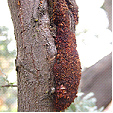 Fruit tree moth borer damage
Fruit tree moth borer damage
The adults female of a fruit tree moth borer normally deposits eggs in damaged areas of the bark or where there is and existing active site. The larvae vary but generally they are creamy to brown, thick soft grub-like reddish brown, and up to 40mm in length.
The adults are white, satiny moths with 40-60mm wingspans with their black abdomens fringed with orange-brown hair or beetle lava that has been deposited in the bark or twigs then tunnels the host.
American Plum Borer (Euzophera semifuneralis) lava is pinkish white to brownish green and attacks the inner bark and cambium region of the tree causing premature death. It is normally found on Platanus orFraxinus species and may also infest many species of fruit trees.
Apple Root Borer (Leptopius squalidus) female adult is a weevil to 20mm long and feeds on the leaves and the plump, legless grub-like lava feeds on the roots of the same host forming tunnels in the deep roots. It is commonly found on Acacia and Eucalyptus species damaging the anchorage of the plant.
Banksia Borer (Cyria imperialis) adult is a black beetle with yellow markings on its wing covers growing to 15mm long. The thickish legless lava is white, tapering from the head and forms flattened tunnels into the heartwood of the host.
Bronze Birch Borer (Agrilus anxius) is a bronze coloured beetle up to 14mm long and lays eggs in crevices in the bark. The legless white larva grows to 20mm long and feeds on the sapwood girdling the branch with flat irregular galleries.
Cedar Tree Borer (Semanotus ligneus) is a black beetle with orange and red markings on its wing covers and grows to 12mm long. The larva feeds on the sapwood of Sequoia, Thuja species and Pinus radiata with curved tunnels that may girdle branches.
Chestnut Borer (Agrilus bilineatus) adult is a tiny slender, blackish green beetle up to 8mm long emerging during spring. The small white larvae have a flat head and are up to 15mm long, forming galleries under the bark of Quercus species.
Cypress Bark Beetle (Phloeosinus cupressi) adult is dark brown with a blackish head, oblong in shape up to 3mm long. The tiny beetles tunnels under the bark of the host and deposits eggs. After hatching the tiny 4mm long, legless larvae bore into the heartwood damaging the tree. After they pupate in the tunnel they emerge through small round holes, commonly many together on the trunk. Damaged trees show signs of browning and dead leaves in the upper branches or falling damage twigs. Cupressus species are particularly vulnerable to attack.
Deodar Weevil (Pissodes nemorensis) is brownish with an obvious snout feeding on the cambium layer and deposits eggs in the bark of the leader and branches. The white lava tunnel the wood eventually killing the leader.
European Corn Borer (Pyrausta nubilalis) is a small moth that lays up to twenty eggs on flower buds. The young flesh coloured larvae mature to a reddish brown and each of its segment has four, spined dark spots.
Elephant Weevil (Orthorhinus cylindrirostris) is a grey or black insect up to 20mm long and lays eggs in the bark near the base of stressed trees. The larva tunnels its way through roots or trunks depositing frass as it goes, then emerging from a second round hole. The adults eat strips from the leaves, normally not bothering the plant.
Elm Borer (Saperda tridentate) adult is a greyish beetle with red bands and black spots on its wing covers and is up to 12mm long. The eggs are laid on the bark and the whitish lava tunnels into the bark and sapwood where it overwinters. It is normally found on Ulmus species.
Iris Borer (Macronoctua onusta) is born from a grey moth with a wing span up to 30mm across, and lays eggs that overwinter in old leaves and debris. As the leaves emerge the eggs hatch entering the leaves at the base, visually forming tunnels and growing to 30mm long. In the later season flower buds may be attacked. Both flowers and leaves eventually turn brown and die.
Lilac Borer (Podosesia syringae) adult is a wasp-like moth that produces pure white lava with a brown head that are up to 25mm long. It initially feeds in the sapwood causing wilting before tunnelling the hardwood making the branches brittle. Evidence of frass is found at the tunnel entrance and secondary fungal attacks infect the holes. Normally found on Syringa species.
Locust Borer (megacyllene robiniae) adult is a black beetle with golden spots, up to 20mm long and produces a small larva that tunnels galleries into the sapwood causing a blackish discolouration. Robinia species are normally attacked.
Mottled Borer (Cryptorhynchus lapathi) attacks Salix species. The adult beetle is black up to 10mm long and the lava bore into the surface of the stem causing swollen growth. Salix species are attacked.
Murry Pine Borer can be two species (Diaoxus erythrurus) and (Diaoxus scalaris). The adults are glossy green-brown beetles that are up to 20mm long and the white grub-like lava is legless, tapering from the head. They tunnel into the sap or hardwood of the trees forming connecting galleries causing ringbarking and creating brittle branches, commonly fond on Callitris species.
Peach Borer (Sanninoidea exitiosa) is a larva that tunnels roots causing gummosis that is mixed with frass at the crown just below soil level. The affected Prunus species produce yellowish leaves and grows poorly. There is another borer, Lesser Peach Borer (Synanthedon pictipes) which attacks any part of the plant from the trunk to the branches and is found on several Prunus species.
Puriri Moth (Aenetus Virescens) a New Zealand short lived moth that grows with a wing span of over 100mm (4in) wide laying eggs on the forest floor at night during spring. The caterpillars grow to 100mm long feeding on leaves and then ascending into the trees and entering the cambium layer up to 150mm deep forming a characteristic '7'-shape burrow that is concealed by frass. The caterpillar may live for 7-years before pupating and collectively they ring bark branches or trunks causing dieback.
Many New Zealand plants including Nothofagus solandri, Pomaderris spp.and ornamentals such as Quercus spp. Betula pendula, Salix spp. Populus spp. Acer spp. Citrus limon and Paulownia spp. are attacked. Control is difficult and generally the plants tolerate attack.
White Pine Weevil (Pissodes strobi) lava feed on the inner bark and sap wood of terminal shoots causing ringbarking and death of the shoot. The reddish brown beetle up to 6mm long is mottled in white and emerges during early summer then lays yellowish lava that are up to 9mm long.
Scribble Moth (Ogmorgraptis scribula) is a grey moth up to 0.4mm wide and produces a cream to brown larvae that is also about 0.4mm long and tunnels in the bark causing a scribble effect. This normally has no detrimental effect on the tree.
Spotted Hemlock Borer (Melanophila fulvoguttata) adult is a colourful metallic beetle with yellowish red spots on the wing covers and lays eggs in cracks in the bark. The white lava is up to 14mm long and forms galleries in the bark and sapwood of the host.
The large Swift Moth and Wood Moths can have a wing span up to 250mm wide and produce large larva that are grub like up to 150mm long, some with horny plates on the thorax. These larvae bore tunnels that are up to 30mm across straight through the heartwood of the host plant. The larvae may live in the tunnel for up to five years before pupating.
Red Cedar Bark Beetle (Phloesinus dentatus) is a small beetle up to 3mm long and lays its larva in excavations in the bark. When the larva emerges they bore galleries in the bark and tend to be more prevalent in stressed or recently transplanted plants.
Vegetable Weevil (Listroderes difficilis) is found during cooler weather (spring or autumn). The adult brown beetle up to 19mm long with a "V" mark on its back and the eggs are laid in the soil around the base of the host plant. The cream coloured lava emerges in spring after rain and feed on the lower leaves forming irregular holes or chewing holes in stems. The lava also feed on fleshy roots boring holes into carrots. Both the adults and lava cause damage, feeding on the plant during the night and resting at the base or under ground during the day. The lava pupates in the soil over winter.
Wattle Web-covering Borer (Cryptophasa rubescens) adult is a satin coloured moth that is up to 50mm across and deposits green fleshy lava that is up to 35mm long. The lava forms shallow tunnels in the bark and sap wood of the host and camouflages it with chewed wood and faeces that is webbed together. Commonly seen attacking the branches on Acacia species.
Life Cycle
These insects have normally have a Holometabolous life cycle. But some borers such as Termites have a Hemimetabolous life cycle.
Eggs are laid singly or in groups, in damaged areas of the bark and branch. Larvae shelter in tunnels they create in the wood and some species may take many years to pupate and emerge as an adult. This may take place in live or dead wood. Other species such as Corn Borer can have up to two generations per year.
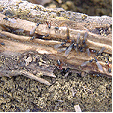 Termites and their damage
Termites and their damage
Distribution of the Pest
Borers are found throughout the world with many species found in Australia both on the coast and inland.
Period of Activity
Varies with the insect concern. Many larvae can be active for many months. Termites are active all year.
Damage Caused
Most damage appears on branches or trunks where the larvae feed on the soft tissue and extensive feeding may cause ring-barking. Normally plants survive borer attack but repetitive attack will cause the death. Certain species are a serious pest in plantations or monocultures such as the Pine Bark Weevil, and the Sirex wood wasp.
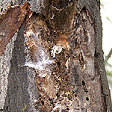 Typical borer damage by a moth larva
Typical borer damage by a moth larva
Chestnut Borer feeds on the sap wood ringbarking large branches and overwinters in the tunnels.
Corn Borer feeds on flower buds and leaves resulting in there death, after which the larva tunnel down the stem causing wilting. There are many crop plants and ornamentals that are affected by this larva.
Swift Moth and Wood Moths weaken trees by boring large tunnels through the branches that may not be noticed until holes are cut through the bark during emergence.
Iris Borer damages leaves to turn brown and wilt, flowers also turn brown and with the aid of a bacterial rot, collapse and die. This damage may be extended to the flower stalk.
Stem Borer (Papaipema nebris) is a small lava to 12mm long, and attacks many garden plants including Lilium, Aster, Alcea and Phlox species
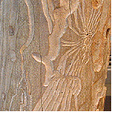 Borer Damage
Borer Damage  Resin oozing from a trunk
Resin oozing from a trunk
Susceptible Plants
There are many plants that are attacked by these pests including Banksia, Callistemon, Melaleuca, Lagerstroemia, Jacaranda species, and flowering stonefruit. Eucalyptus, Acacia species and many ornamental such as Acer species. Plants that are stressed, are particularly venerable.
Acacia and Eucalyptus species are attacked by Swift Moths and Wood Moths.
Acacia species are susceptible to attack from the Wattle Web-covering Borer (Cryptophasa rubescens), which weakens and causes die back of branches.
Acer platanoides is attacked by the Leaf Stalk Borer (Nepticula albostriella) that tunnels into the petiole of the leaf turning it blackish and also attacks the fruit.
Acer saccharinum is attacked by the Petiole Borer (Caulocampus acericaulis) which tunnels in the petioles. It generally attacks the leaves on the lower branches causing them to fall.
Acer species may also be attacked by several borers including the Flat Headed Borer (Chrysobothris femorata), a 25mm long lava of a coppered coloured beetle, that tunnels galleries under the bark girdling the trees The Sugar Maple Borer (Glycobius speciosus) which girdles branches killing them and the Leopard Moth (Zeuzera pyrina) lava that tunnels large holes into branches making them structurally weak. This lava can grow to 80mm long and 12mm thick overwintering in the tunnels.
Banksia species are attacked by the Banksia Web-covering Borer (Xylorycta strigata) a greenish lava up to 40mm long that tunnels down the centre of branch tips. The entrance is covered in silken web littered with faecal material and causes the death of the branchlets.
Betula and Populus species are attacked with the Bronze Birch Borer (Agrilus anxius) and heavy infestation may kill the tree. Populus species are also attacked by the Poplar Borer (Saperda calcarate).
Brachychiton species are attacked by the Kurrajong Weevil (Axionicus insignis) the lava of this plump greyish weevil is white and legless, entering the plant through wounds forming rounded tunnels that may girdle the tree, killing it.
Carya species are attacked by the Painted Hickory Borer (Megacyllene caryae). The adult dark brown beetle has obvious zig zag lines on its wing covers and the lava is cream coloured, both up to 20mm long. The lava tunnels the sapwood of living trees causing ring barking and also tunnels dead trees.
Cornus species are attacked by several borers such as the Flat Headed Borer (Chrysobothris femorata) and the Dogwood Borer (Thamnosphecia scitula).
Cupressus species are attacked by the Cypress Bark Beetle (Phloeosinus cupressi) causing the branches to turn brown and die off from the top or causing the leaves to wilt. On first indication of infestation selective prune off damaged areas or remove the tree.
Hakea sericea and other Hakea species are attacked by the Web-covering Borer (Neodrepta luteotactella). The larvae bore into the twigs and fruit forming a small covering of frass. This insect also infects Macadamia species. Hakeas are also attacked by several other web-covering borers.
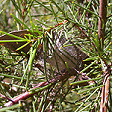 Hakea sericea
Hakea sericea
Pinus and Picea species are attacked by the White Pine Weevil (Pissodes strobi) in the northern hemisphere.
Samanea saman is attacked by the borer (Xystrocera globosa) which chews into the sap wood of stressed trees and can cause serious damage.
Sorbus aucuparia is attacked by the Round Headed Borer (Saperda candida) which forms galleries in the trunk at ground level, forming round holes in the bark.
Tilia species are attacked by the European Bark Borer (Chrysoclista linneela), which feeds on the bark and thew Linden Borer (Saperda vestita) that attacks the base of the trunk or roots.
Tsuga species are attacked by Spotted Hemlock Borer (Melanophila fulvoguttata).
Vaccinium ovatum is infested by the Azalea Stem Borer (Oberea myops). The yellowish lava of this beetle bores into the tips of stems during the flowering period and is up to 12mm (½in) long. It is also commonly found on Rhododenron species.
Control
Cultural Control
Larvae may be destroyed after exposure by pulling away the covering pad of frass, or by pushing a length of wire into the tunnel. Damaged branches may be removed. Improve the culture by feeding and watering the plant.
 Frass due to the Fruit tree moth borer
Frass due to the Fruit tree moth borer
Biological Control
No effective biological control though certain species of trees exude gum or resin sealing the holes and limiting the activity of the larvae or causing its death.
Chemical Control
There is no satisfactory chemical control most borers of live wood.
Note
It is your responsibility by law to read & follow the directions on the label of any pesticide
PEST
NAME
Looper Caterpillars
Various Looper Caterpillar Species
ORDER
Lepidoptera
FAMILY
Noctuidae
Description of the Pest
The looper is so-called because of the larvae's characteristic "looping" movement: the back legs move forward behind the front legs, causing the body to arch into an inverted "U" shape. They vary in colour and size; Brown Looper (Lophodes sinistraria) can grow to 50mm long, glossy black with yellowish bands then maturing to brown and found in coastal sub-tropical regions.
Green Wattle Looper (Thalaina species) adult is a small white moth with a wing span of 40mm and the lava is a slender green caterpillar with a rounded head. It is commonly found on ferny leaves Acacia species and when it is not feeding it takes up an erect position imitating a twig growing at an angle. It is difficult to detect and normally not requiring control.
Grevillea Lopper (Oenochroma vinaria) is a slender caterpillar that is greyish with orange bands and has two thorn-like projections on its back towards the head that it uses in a defence position. It is hairless with mottled orange colouring and grows to 80mm long. The adult moth (pink belly moth) has a wing span up to 60mm across and is pinkish.
Brown Looper (Lophodes sinistraria) are black with yellowish bands at first maturing to brown growing to 50mm long. It is a solitary feeder eating mature leaves and are found in tropical to sub tropical regions.
Appearance and Distribution of the Pest
Many species are found throughout Australia from tropical to temperate regions.

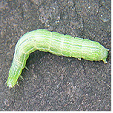
Life Cycle
These insects have a Holometabolous life cycle, ie. When metamorphosis is observed during the pupal stage.
Period of Activity
Most active during the warmer months the larva feed generally in the early morning or in the evening. Caterpillars are also active during cloudy days.
Damage Caused
Larvae are voracious feeders, skeletonising leaves or stripping them to the midrib preferring new growth.. Certain species feed solitary while others in groups.
The Grevillea Lopper feeds solitary or in groups defoliating small areas in species such as Lambertia and Grevillea.
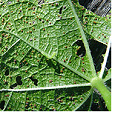
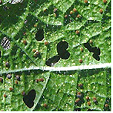
Susceptible Plants
A wide range of native and exotic plants are attacked, depending on the species of looper. Plants with soft-textured foliage (eg vegetables, some indoor plants) are preferred. The Brown Looper is found on Acmena smithii, Waterhousea floribunda and Macadamia species.
Tropaeolum and Calendula species are attacked by the Cabbage Looper (Trichoplusia ni), which feeds on the leaves and flowers.Tropaeolum species are also attacked by the caterpillar (Pieris rapae), which eats the foliage.
Cultural Control
Small numbers may be removed by hand.
Biological Control
Birds and other predators reduce numbers.
Chemical Control
The plant may be sprayed using Carbaryl. During heavy infestations this method is effective.
Note
Always read the label for registration details and direction of use prior to application of any chemicals.
PEST
NAME
Chinese Wax Scale
Ceroplastes sinensis
ORDER
Hemiptera
FAMILY
Coccidae
Description of the Pest
This domed scale is about 7 mm long has four white stripes and three dark depressions on either side of the waxy shell. The wax is hard, white to brownish. In spring it may be half pinkish and white in colour.
Both the adults and the nymphs including the crawler stage have piercing and sucking mouth parts.
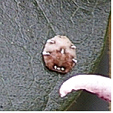
Life Cycle The insect has a hemimetabolous life cycle consisting of nymphs and adults.
The first nymphal stage which has mobility is called, a crawler.
The crawlers hatch and wander around the leaf surface until finding a suitable place to settle.
There is one generation per year. The females die after giving birth to up to 5,000 eggs. These remain with the dead female until they emerge as crawlers.
Distribution of the Pest
World wide including most of Australia
Period of Activity
The nymphs are active for most of the year and are found in coastal sub tropical to temperate regions.
Susceptible Plants
There is a wide range of susceptible plants including plants in the Myrtaceae, Melaleuca species, Callistemon species Rutaceae families including Citrus, Citrus deliciosa (mediterranean mandarin), Citrus limon (lemon), Citrus reticulata (mandarin), Citrus sinensis (navel orange), Citrus unshiu (satsuma), Mangifera indica (mango). It also feeds on Pittosporum species, Hibiscus, Avocado, Prunus spp. It also attacks indoor or glasshouse plants. It is found on a very wide range of plants over 60 species. In March
Damage Caused
They are commonly seen on the stems and on both sides of the leaves where the young scale form colonies mainly along the mid ribs of leaves. They are commonly accompanied by ants that attend and protect them while harvesting the large quantities of honey dew that the scales are producing.
Leaves become yellow and are shed prematurely and there may be stem die-back. Small trees and saplings that are heavily infested may be seriously damaged. Large amounts of honeydew are produced, this attracts sooty mould.
Sooty mould can cover fruit or leaves causing a secondary problem such as reducing the ability for photosynthesis, it the appearance of the plant is spoilt.
Control
Cultural Control
Not feasible if infestation severe in most cases.
Biological Control
A parasitic wasp Scutellista cyonea can help in reducing the populations
Chemical Control
Oil sprays are 'soft' on beneficial insects and, if applied at the right time and with good coverage, may control the scale without causing any damage to the tree, if the directions on the pesticide label are followed
The oils can suffocate the crawlers if timed correctly.
Note
It is your responsibility by law to read & follow the directions on the label of any pesticide
Monitoring
Double sided sticky tape can be placed around some of the young stems above where their mothers are. In late February when the crawlers emerge from their dead mother some crawlers will adhere to the sticky tape. When numbers are high spray the new growth with soapy water, or an oil based product. This will suffocate the crawlers by blocking their spiracles.
Amendments by B. Sonsie Dip Hort Sc Burnley
PEST
NAME
Pimple Psyllid
Trioza eugeniae
ORDER
Hemiptera
FAMILY
Psyllidae
Description of the Pest
The adult is a 2mm long winged lerp insect. Nymphal stages are initially mobile, selecting a site to settle down and feed by sucking sap from the underside of the leaves. Leaves develop bright red "pimples" or galls on the upper surfaces, corresponding to the points at which feeding occurs on the lower leaf surface.
Laurel Psyllid (Trioza alacris) is a European species, where the eggs are laid on the leaf margins and the nymphs make them curl.
Appearance and Distribution of the Pest
This psyllid is found in tropical to warm temperate regions, particularly on the coast.
Life Cycle
This insect has a Hemimetabolous life cycle, ie. When the immature nymphs resemble the adults.
Five nymphal stages occur before the adult stage.
Period of Activity
Most activity occurs in Spring, when new growth is attacked, although the larvae may feed from Autumn, through Winter, to Spring.
Damage Caused
Leaves are distorted and disfigured by the galls. However, the plant's growth is not usually impaired but in heavy infestations die back can occur.


Susceptible Plants
Lillypillies (especially Syzygium australae, S.coolminianum and. S. paniculatum).
Cultural Control
No satisfactory controls.
Biological Control
Natural predators make little difference to numbers.
Chemical Control
Not normally indicated; nursery stock may be sprayed with systemic insecticides as soon as the pest is detected.
Note
Always read the label for registration details and direction of use prior to application of any chemicals.
PEST
NAME
Leaf Hopper (General)
Various Leaf Hopper Species
ORDER
Hemiptera
FAMILY
Eurytomidae
Description of the Pest
Generally hopper grows up to 15mm in length, with "A"-shaped folded wings that give it a characteristic triangular cross-section. The adults often have bright coloured markings and the nymphs conjugate in colonies. Adults can fly but will hop away immediately if disturbed and both nymphs and mature hoppers have piercing and sucking mouth parts.
The Passion Vine Hopper (Scolypopa australis) has clear triangular wings that have brown margins and black bands. The nymphs are wingless and white with tufts of hair on the end of the abdomen.
The Green Leaf Hopper (siphanta acuta) looks triangular with its steeply folded wings and can grow to 10mm long. The adults are generally a solitary feeder but the nymphs congregate on shoots.
Appearance and Distribution of the Pest
The adults and nymphs are present throughout the year in tropical to warm temperate regions and are dispersed by flying.
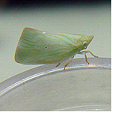

Life Cycle
These insects have a Hemimetabolous life cycle, ie. When the immature nymphs resemble the adults.
Females deposit eggs in slits they make in the bark or on the leaves of the host, and several generations may appear annually on the same plant.
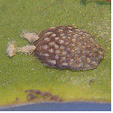 Egg and Nymph
Egg and Nymph 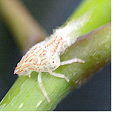
Damage Caused
Nymphs and adults are gregarious, and both stages may be found on host plants at the same time. If large numbers attack young new growth, sucking sap from leaf petioles and young stems, the host plant may become stressed. Severe infestations may weaken and eventually kill the plant with dieback and distorted leaves.
The nymphs exude a sweet secretion, which is attractive to ants that attend and protect the colony. The honeydew also causes sooty mould to occur as a secondary problem. Some species produce toxic saliva that kills the effected plant tissue; other species carry plant viruses.
Susceptible Plants
Most Eucalyptus, Acacia and Casuarina species are attacked by a variety of leafhoppers. Many other Australian native and ornamental plants are attacked.
Acer species are attacked by the leaf hopper (Alebra albostriella) which lays eggs under the bark causing minor swelling. Acer platanoides is particularly venerable.
Callistephus and Aster species are attacked by the Leaf Hopper (Macrosteles fascifrons) that generally causes little harm to the plant but transmits Yellow Disease, a viral infection.
Fern species are attacked by several types of leaf hopper, particularly the Passion Vine Hopper (Scolypopa australis). New fronds become deformed or misshapen as the insect sucks the sap causing dead patches to appear.
Parthenocissus species are attacked by the Green Leaf Hopper.
Rosa species are attacked by the Rose Leaf-hopper (Edwardsiana rosae), nymphs feed on the underside of leaves causing white blotches.
Sorbus aucuparia is attacked by the Japanese Leaf Hopper (Orientus ishidae) which causes the leaves to form a brown blotches with yellowish margins.
Cultural Control
Improving the culture of the host species may assist in maintaining vigorous growth, to minimise shock from infestations. It may be possible to remove them by hand, from young trees, using a small butterfly net if you are lucky.
Biological Control
Controlled by natural predation and the Green Leaf Hopper causes little harm and control is unnecessary.
Chemical Control
Under normal circumstances, it is impractical and unnecessary to treat mature trees however, hoppers on young plants may be treated with a contact insecticide. Note
Always read the label for registration details and direction of use prior to application of any chemicals.
DISEASE
NAME
Sooty Mould
Various Sooty Mould Species
Description
A fungal problem related to honeydew that is secreted from other insects. The fungus will not infect the host plant.
Symptoms
A soot-like dry black fungus appears on areas of the plant where honeydew is found. The fungus spreads and becomes thick restricting the plants capability to photosynthesize. The fungus can also appear on fruit spoiling its appearance and gives the plant an unattractive look.
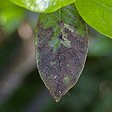
 Gardenia augusta
Gardenia augusta
Source and Dispersal
It is found on other infected plants and soon spreads by wind to other susceptible plants.
Favoured Conditions
It is occurs when insects are producing honeydew, normally through the growing period.
Affected Plants
These fungi can found on most plants particular plants that are infected with scale insect that produces honeydew.
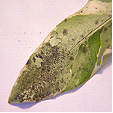 Pittosporum eugenioides
Pittosporum eugenioides 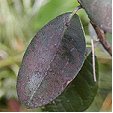 Camellia japonica
Camellia japonica
Callicarpa species are infected with Black Mould (Meliola cookeana) with its black mycelium growing on all parts of the plant including twigs and leaves.
Non-chemical Control
To reduce sooty mould it is required to controlling insect numbers on the plant. Affected plants may have the dry sooty mould rubbed or hosed off.
Chemical Control
Fungicides are not required, but the control of the insect producing honeydew is required.
Note
Always read the label for registration details and direction of use prior to application of any chemicals.
DISEASE
NAME
Lichens
Various Lichen Species
Description
A fungus and an alga growing in a symbiotic relationship. The food producing alga is given support and shelter by the fungus.
Symptoms
Lichens are variable, occurring in many shapes, sizes and colours from flat to circular and may be leaf like crinkly or hairy. The colour also varies from greenish grey to yellow or orange. They occur on many surfaces including tree trunks, rocks, fences and roof tiles. They cause little harm to living plants and certain types are attractive while others are unsightly.
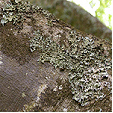 Fagus sylvatica
Fagus sylvatica 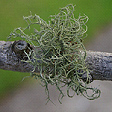
Source and Dispersal
Contaminated areas, and is dispersed by wind or splashing water.
Favoured Conditions
Conditions are variable as some types prefer cool moist situations while others tolerate open exposed positions.
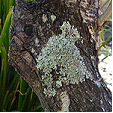
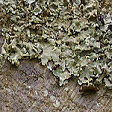
Affected Plants
There are many plants that form lichens on the bark, particular old woody trees that are in shaded moist positions. Shrubs and Palms also form coverage of lichens on there stems under moist conditions.
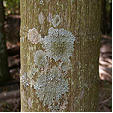 Archontophoenix cunninghamiana
Archontophoenix cunninghamiana 
Non-chemical Control
Under normal circumstances, unnecessary but lichens can be removed by scraping or scrubbing.
Chemical Control
Not normally required but lichens can be killed by spraying the fungicide copper oxychloride but take care as the chemical may damage certain building materials.
Note
Always read the label for registration details and direction of use prior to application of any chemicals.
Average Lowest Temperature : -1º C 30º F
USDA : 9, 10, 11
This USDA (United States Department of Agriculture) hardiness zone chart can be used to indicate a plant’s ability to withstand average minimum temperatures. However, other factors such as soil type, pH, and moisture, drainage, humidity and exposure to sun and wind will also have a direct effect on your plant’s survival. Use this chart only as a guide, always keep the other factors in mind when deciding where, when and what to plant.
A plant's individual USDA zone can be found in the Plant Overview.
Region of origin

Australia (east coast)
Climate Description
Warm to Sub-tropical
This overlaping zone has ample rain with high summer temeperatures and high humidity. Winters are mild. Pockets of sub-tropical climates exist within coastal warm temperate zones.
Frosts and droughts rarely occur along the coast.
Plant growth
Tropical and warm temperate native and exotic plants grow well.
| Dictionary | Growth Habit |
| Leaf Type | Botanic Flower Description |
| Leaf Shape | Flower Inflorescence |
| Leaf Arrangement | Fruit Type |
| Leaf Margin | Bark Type |
| Leaf Apex And Bases | Flower Description |